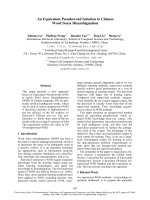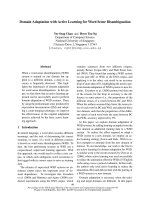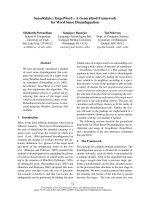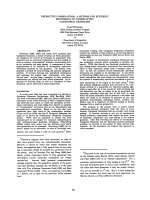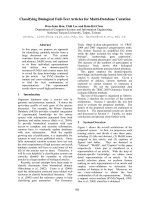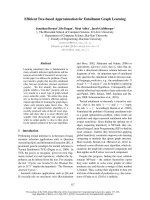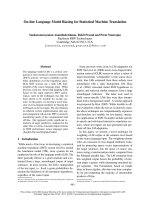Báo cáo khoa học: "SenseRelate::TargetWord – A Generalized Framework for Word Sense Disambiguation" doc
Bạn đang xem bản rút gọn của tài liệu. Xem và tải ngay bản đầy đủ của tài liệu tại đây (51.52 KB, 4 trang )
Proceedings of the ACL Interactive Poster and Demonstration Sessions,
pages 73–76, Ann Arbor, June 2005.
c
2005 Association for Computational Linguistics
SenseRelate::TargetWord – A Generalized Framework
for Word Sense Disambiguation
Siddharth Patwardhan
School of Computing
University of Utah
Salt Lake City, UT 84112
Satanjeev Banerjee
Language Technologies Inst.
Carnegie Mellon University
Pittsburgh, PA 15213
Ted Pedersen
Dept. of Computer Science
University of Minnesota
Duluth, MN 55812
Abstract
We have previously introduced a method
of word sense disambiguation that com-
putes the intended sense of a target word,
using WordNet-based measures of seman-
tic relatedness (Patwardhan et al., 2003).
SenseRelate::TargetWord is a Perl pack-
age that implements this algorithm. The
disambiguation process is carried out by
selecting that sense of the target word
which is most related to the context words.
Relatedness between word senses is mea-
sured using the WordNet::Similarity Perl
modules.
1 Introduction
Many words have different meanings when used in
different contexts. Word Sense Disambiguation is
the task of identifying the intended meaning of a
given target word from the context in which it is
used. (Lesk, 1986) performed disambiguation by
counting the number of overlaps between the dic-
tionary definitions (i.e., glosses) of the target word
and those of the neighboring words in the con-
text. (Banerjee and Pedersen, 2002) extended this
method of disambiguation by expanding the glosses
of words to include glosses of related words, accord-
ing to the structure of WordNet (Fellbaum, 1998).
In subsequent work, (Patwardhan et al., 2003) and
(Banerjee and Pedersen, 2003) proposed that mea-
suring gloss overalps is just one way of determin-
ing semantic relatedness, and that word sense dis-
ambiguation can be performed by finding the most
related sense of a target word to its surrounding con-
text using a wide variety of measures of relatedness.
SenseRelate::TargetWord is a Perl package that
implements these ideas, and is able to disambiguate
a target word in context by finding the sense that is
most related to its neighbors according to a speci-
fied measure. A user of this package is able to make
a variety of choices for text preprocessing options,
context selection, relatedness measure selection and
the selection of an algorithm for computing the over-
all relatedness between each sense of the target word
and words in the surrounding context. The user can
customize each of these choices to fit the needs of
her specific disambiguation task. Further, the vari-
ous sub-tasks in the package are implemented in a
modular fashion, allowing the user to easily replace
a module with her own module if needed.
The following sections describe the generalized
framework for Word Sense Disambiguation, the ar-
chitecture and usage of SenseRelate::TargetWord,
and a description of the user interfaces (command
line and GUI).
2 The Framework
The package has a highly modular architecture. The
disambiguation process is divided into a number of
smaller sub-tasks, each of which is represented by
a separate module. Each of the sequential sub-tasks
or stages accepts data from a previous stage, per-
forms a transformation on the data, and then passes
on the processed data structures to the next stage in
the pipeline. We have created a protocol that defines
the structure and format of the data that is passed
between the stages. The user can create her own
73
Relatedness
Measure
Context
Target Sense
Preprocessing
Format Filter
Sense Inventory
Context Selection
Postprocessing
Pick Sense
Figure 1: A generalized framework for Word Sense Disambiguation.
modules to perform any of these sub-tasks as long
as the modules adhere to the protocol laid down by
the package.
Figure 1 projects an overview of the architecture
of the system and shows the various sub-tasks that
need to be performed to carry out word sense dis-
ambiguation. The sub-tasks in the dotted boxes are
optional. Further, each of the sub-tasks can be per-
formed in a number of different ways, implying that
the package can be customized in a large number of
ways to suit different disambiguation needs.
2.1 Format Filter
The filter takes as input file(s) annotated in the
S
ENSEVAL-2 lexical sample format, which is an
XML–based format that has been used for both the
S
ENSEVAL-2 and SENSEVAL-3 exercises. A file in
this format includes a number of instances, each one
made up of 2 to 3 lines of text where a single tar-
get word is designated with an XML tag. The fil-
ter parses the input file to build data structures that
represent the instances to be disambiguated, which
includes a single target word and the surrounding
words that define the context.
2.2 Preprocessing
SenseRelate::TargetWord expects zero or more text
preprocessing modules, each of which perform a
transformation on the input words. For example, the
Compound Detection Module identifies sequences
of tokens that form compound words that are known
as concepts to WordNet (such as “New York City”).
In order to ensure that compounds are treated as a
single unit, the package replaces them in the instance
with the corresponding underscore–connected form
(“New
York City”).
Multiple preprocessing modules can be chained
together, the output of one connected to the input of
the next, to form a single preprocessing stage. For
example, a part of speech tagging module could be
added after compound detection.
2.3 Context Selection
Disambiguation is performed by finding the sense of
the target word that is most related to the words in
its surrounding context. The package allows for var-
ious methods of determining what exactly the sur-
rounding context should consist of. In the current
implementation, the context selection module uses
an n word window around the target word as con-
text. The window includes the target word, and ex-
tends to both the left and right. The module selects
the n − 1 words that are located closest to the target
word, and sends these words (and the target) on to
the next module for disambiguation. Note that these
words must all be known to WordNet, and should
not include any stop–words.
However, not all words in the surrounding context
are indicative of the correct sense of the target word.
An intelligent selection of the context words used in
the disambiguation process could potentially yield
much better results and generate a solution faster
than if all the nearby words were used. For exam-
ple, we could instead select the nouns from the win-
dow of context that have a high term–frequency to
document–frequency ratio. Or, we could identify
lexical chains in the surrounding context, and only
include those words that are found in chains that in-
clude the target word.
74
2.4 Sense Inventory
After having reduced the context to n words, the
Sense Inventory stage determines the possible senses
of each of the n words. This list can be obtained
from a dictionary, such as WordNet. A thesaurus
could also be used for the purpose. Note however,
that the subsequent modules in the pipeline should
be aware of the codes assigned to the word senses.
In our system, this module first decides the base
(uninflected) form of each of the n words. It then
retrieves all the senses for each word from the sense
inventory. We use WordNet for our sense inventory.
2.5 Postprocessing
Some optional processing can be performed on the
data structures generated by the Sense Inventory
module. This would include tasks such as sense
pruning, which is the process of removing some
senses from the inventory, based on simple heuris-
tics, algorithms or options. For example, the user
may decide to preclude all verb senses of the target
word from further consideration in the disambigua-
tion process.
2.6 Identifying the Sense
The disambiguation module takes the lists of senses
of the target word and those of the context words and
uses this information to pick one sense of the tar-
get word as the answer. Many different algorithms
could be used to do this. We have modules Local
and Global that (in different ways) determine the re-
latedness of each of the senses of the target word
with those of the context words, and pick the most
related sense as the answer. These are described
in greater detail by (Banerjee and Pedersen, 2002),
but in general the Local method compares the target
word to its neighbors in a pair-wise fashion, while
the Global method carries out an exhaustive compar-
ison between all the senses of the target word and all
the senses of the neighbors.
3 Using SenseRelate::TargetWord
SenseRelate::TargetWord can be used via the
command-line interface provided by the utility pro-
gram called disamb.pl. It provides a rich variety of
options for controlling the process of disambigua-
tion. Or, it can be embedded into Perl programs,
by including it as a module and calling its various
methods. Finally, there is a graphical interface to
the package that allows a user to highlight a word in
context to be disambiguated.
3.1 Command Line
The command-line interface disamb.pl takes as input
aS
ENSEVAL-2 formatted lexical sample file. The
program disambiguates the marked up word in each
instance and prints to screen the instance ID, along
with the disambiguated sense of the target word.
Command line options are available to control the
disambiguation process. For example, a user can
specify which relatedness measure they would like
to use, whether disambiguation should be carried out
using Local or Global methods, how large a win-
dow of context around the target word is to be used,
and whether or not all the parts of speech of a word
should be considered.
3.2 Programming Interface
SenseRelate::TargetWord is distributed as a Perl
package. It is programmed in object-oriented Perl
as a group of Perl classes. Objects of these classes
can be instantiated in user programs, and meth-
ods can be called on these objects. The pack-
age requires that the Perl interface to WordNet,
WordNet::QueryData
1
be installed on the system.
The disambiguation algorithms also require that the
semantic relatedness measures WordNet::Similarity
(Pedersen et al., 2004) be installed.
3.3 Graphical User Interface
We have developed a graphical interface for the
package in order to conveniently access the disam-
biguation modules. The GUI is written in Gtk-Perl
– a Perl API to the Gtk toolkit. Unlike the command
line interface, the graphical interface is not tied to
any input file format. The interface allows the user to
input text, and to select the word to disambiguate. It
also provides the user with numerous configuration
options corresponding to the various customizations
described above.
1
/>75
4 Related Work
There is a long history of work in Word Sense Dis-
ambiguation that uses Machine Readable Dictionar-
ies, and are highly related to our approach.
One of the first approaches was that of (Lesk,
1986), which treated every dictionary definition of
a concept as a bag of words. To identify the in-
tended sense of the target word, the Lesk algorithm
would determine the number of word overlaps be-
tween the definitions of each of the meanings of the
target word, and those of the context words. The
meaning of the target word with maximum defini-
tion overlap with the context words was selected as
the intended sense.
(Wilks et al., 1993) developed a context vector
approach for performing word sense disambigua-
tion. Their algorithm built co-occurrence vectors
from dictionary definitions using Longman’s Dictio-
nary of Contemporary English (LDOCE). They then
determined the extent of overlap between the sum of
the vectors of the words in the context and the sum
of the vectors of the words in each of the definitions
(of the target word). For vectors, the extent of over-
lap is defined as the dot product of the vectors. The
meaning of the target word that had the maximum
overlap was selected as the answer.
More recently, (McCarthy et al., 2004) present a
method that performs disambiguation by determing
the most frequent sense of a word in a particular do-
main. This is based on measuring the relatedness
of the different possible senses of a target word (us-
ing WordNet::Similarity) to a set of words associated
with a particular domain that have been identified
using distributional methods. The relatedness scores
between a target word and the members of this set
are scaled by the distributional similarity score.
5 Availability
SenseRelate::TargetWord is written in Perl and is
freely distributed under the Gnu Public License. It
is available via SourceForge, an Open Source de-
velopment platform
2
, and the Comprehensive Perl
Archive Network (CPAN)
3
.
2
3
/>TargetWord
6 Acknowledgements
This research is partially supported by a National
Science Foundation Faculty Early CAREER Devel-
opment Award (#0092784).
References
S. Banerjee and T. Pedersen. 2002. An adapted Lesk
algorithm for word sense disambiguation using Word-
Net. In Proceedings of the Third International Confer-
ence on Intelligent Text Processing and Computational
Linguistics, Mexico City, February.
S. Banerjee and T. Pedersen. 2003. Extended gloss over-
laps as a measure of semantic relatedness. In Pro-
ceedings of the Eighteenth International Conference
on Artificial Intelligence (IJCAI-03), Acapulco, Mex-
ico, August.
C. Fellbaum, editor. 1998. WordNet: An electronic lexi-
cal database. MIT Press.
M. Lesk. 1986. Automatic sense disambiguation using
machine readable dictionaries: How to tell a pine cone
from a ice cream cone. In Proceedings of SIGDOC
’86.
Diana McCarthy, Rob Koeling, Julie Weeds, and John
Carroll. 2004. Finding predominant word senses
in untagged text. In Proceedings of the 42nd Meet-
ing of the Association for Computational Linguistics
(ACL’04), Main Volume, pages 279–286, Barcelona,
Spain, July.
S. Patwardhan, S. Banerjee, and T. Pedersen. 2003. Us-
ing measures of semantic relatedness for word sense
disambiguation. In Proceedings of the Fourth In-
ternational Conference on Intelligent Text Processing
and Computational Linguistics (CICLING-03),Mex-
ico City, Mexico, February.
Ted Pedersen, Siddharth Patwardhan, and Jason Miche-
lizzi. 2004. Wordnet::Similarity - Measuring the Re-
latedness of Concepts. In Daniel Marcu Susan Du-
mais and Salim Roukos, editors, HLT-NAACL 2004:
Demonstration Papers, pages 38–41, Boston, Mas-
sachusetts, USA, May 2 - May 7. Association for
Computational Linguistics.
Y. Wilks, D. Fass, C. Guo, J. McDonald, T. Plate, and
B. Slator. 1993. Providing machine tractable dictio-
nary tools. In J. Pustejovsky, editor, Semantics and
the Lexicon. Kluwer Academic Press, Dordrecht and
Boston.
76

